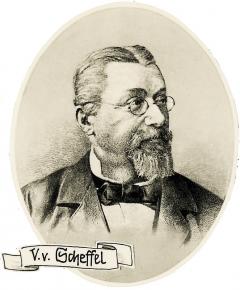Victor von Scheffel
The writer who described the “Lande um den Main” (the land around the Main): Victor von Scheffel
He is the writer who erected a poetic memorial to all of Franconia, which
would later become widely known as the hymn of Franconia: Victor von Scheffel.
The lawyer became famous, but not in his legal capacity, rather as a writer and
poet, for example with the novel “Der Trompeter von Säckingen” (The Trumpeter
of Säckingen). The “broad pasture divided by a shining stream” around Bad
Staffelstein, in particular the Staffelberg mountain and Banz Abbey, were made
famous nationwide by the song of Franconia “Wohlauf, die Luft geht frisch und
rein” (“Get up, the air blows fresh and clean”), that he wrote in the “Eden on
the Upper Main” in 1859, and therefore discovered for Germany-wide tourism. The
poem was set to music in 1870 by Valentin Becker and today it is the quintessential
Franconian hymn.

Victor
von Scheffel, born in 1826, arrived in Lichtenfels by train on 11 July 1859 and
walked up to Banz Castle. He was supposedly melancholic then, and it is said
that his trip was intended to heal him spiritually and physically. He was about
to decide whether to return to his civil servant life or to go into service as
a writer. This is why he wanted to be alone in brilliant summer weather,
letting nature take its effect on him and to go on vast walks to Staffelstein,
to the hermitage on the Staffelberg mountain, to the pilgrimage basilica of Vierzehnheiligen
(the Fourteen Holy Helpers), to Steglitz castle and into Franconian
Switzerland. In 1897, the son and daughter of the innkeepers, the Schonath
family, remembered that they would often have to go hiking with Scheffel and
for guiding him to Steglitz castle once received a shiny silver coin from “the
lank and gaunt Doctor Scheffel”, as they called him. The cheerful time in Banz
and its surroundings gave the not always fortunate poet the opportunity to
rethink and organize his life.
In the
mid-19 th century, literary regionalism received a sustainable boost
thanks to historicising narrators and poets. This is the so-called
“Butzenscheibenromantik” (stained glass romanticism). The novels resonated
strongly among the middle classes. In 1876, Scheffel was raised to nobility. He
died on 9 April 1886 in Karlsruhe. An official of the Staffelstein district
authority, Mr. Badum, compiled a collection of pre- and early historical finds
in his own home and called it the Scheffel Museum, which finally became the
town museum we have today.
On the 125 th anniversary of Scheffel’s death in 2011, his own department of the museum was established in his honour.
A special department about Victor von Scheffel is located in the City-Museum of Bad Staffelstein.


